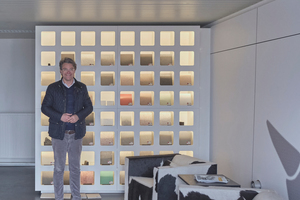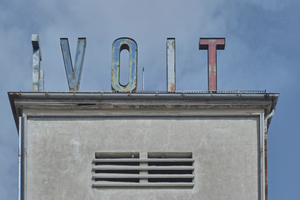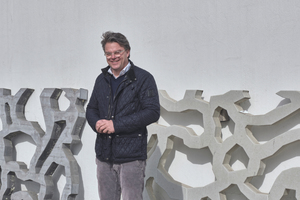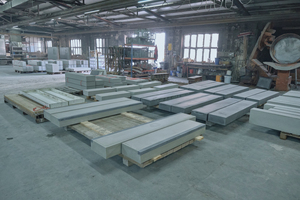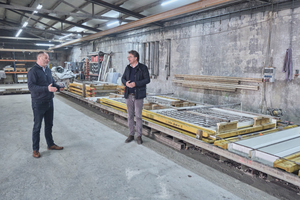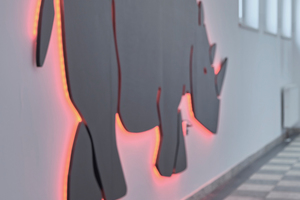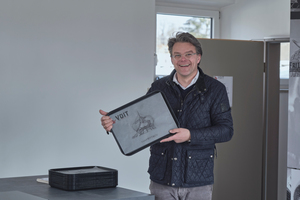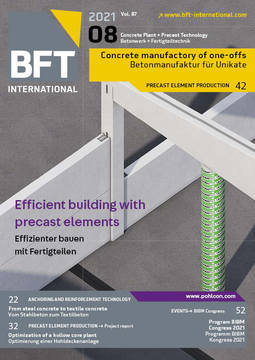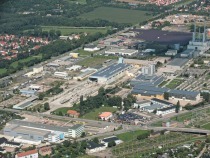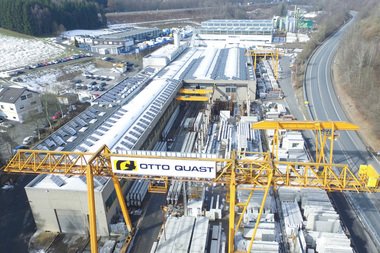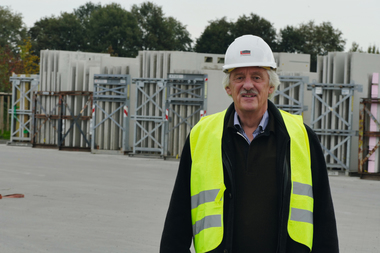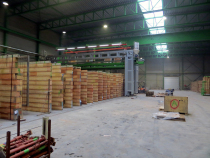Voit Beton – manufactory of one-offs
The former industry’s slogan “Concrete – it depends what you make of it” has been interpreted in hardly as many different ways and in so many variations as by Erwin Voit. He is the founder and managing owner of Voit Betontechnische Spezialfabrik GmbH in Amberg, Germany. The BFT editorial office thanks Opterra GmbH and Sven-Erik Tornow for making this article available.
The former industry’s slogan “Concrete – it depends what you make of it” has been interpreted in hardly as many different ways and in so many variations as by Erwin Voit. He is the founder and managing owner of Voit Betontechnische Spezialfabrik GmbH in Amberg in Germany. With his company he summarizes what sounds so complicated in simple and clear terms: Voit Beton – forms of strength.
This passion for concrete material is no accident. Already his grandfather founded in 1946 a concrete plant in Amberg in Germany – although he and his family had not even come from there. As refugees, they had settled in the historic town and rebuilt their lives with the production of concrete products. Masonry blocks and hollow blocks were construction materials in high demand for reconstruction after the war. Later, additional products were added: patio and terrazzo tiles, windowsills, sidewalk slabs and staircase steps. The company grew as demand grew – and demand continued high.
Concrete products boom
In the 1970s exposed-aggregate concrete slabs experienced a strong phase. Landscaping products became one of the pillars of the concrete products business. “In the 90s, we expanded into the new states of reunited Germany,” remembers Erwin Voit. Project-related business was increasingly added to landscaping products. “More and more products for the interior were manufactured – stair steps, slabs, ground products.” For the German government in Berlin and for large shopping centers, Voit also took on installation owing to the lack of specialized firms.
New beginning instead of restructuring
In 2000 business collapsed. The market no longer developed as expected. This also had consequences for the Amberg concrete plant. Despite all efforts to avert closure, economic breakdown followed. Erwin Voit recalls, “Then, in 2001, I founded my own company – virtually on the same foundations of the concrete plant that my grandfather had done in the past. We specialized in customized special products for outdoor use from the start.” In addition to seating furniture and bordering elements, the company developed design elements for outdoor kitchens. In mid-2010, the concrete component experts manufactured heat-resistant lining panels for an oven manufacturer. “I always wanted to set up the company with a portfolio as diversified as possible so as not become dependent on one market segment.”
Close ties to customers
The customers base is just as mixed. Among around 70 regular customers are garden and landscaping companies, construction companies, building materials dealers and landscape architects. No matter from what direction the inquiry or the order comes, customized special products, most of which individually manufactured, are always involved. “For orders manufactured in series or with the required machines, we are not competitive in our “concrete manufactory” clarifies Erwin Voit. Therefore, the Amberg company manufactures in the truest sense of the word unique façade elements, water fountain systems, seating elements, washstands, concrete bowls, garden walls, water walls, floor covering and ground fair-faced concrete steps for interior finishing work.
One-offs from Amberg
Production takes place on the company-owned property in a hall measuring 900 m². Currently, the products remain there until sufficiently hardened. Then they can be placed in intermediate storage in the outdoor storage facilities for further transport to the customer or the construction site. In reality, however, the production process begins much earlier: “Initially, we receive an inquiry asking whether the manufacture of the desired special part is at all feasible,” as concrete expert Erwin Voit explains the most time-consuming creation process. Next, the possibilities are explored in close collaboration with the customer, drawings made and the appropriate formwork built. “Our team is optimally put together,” continues Voit. “A construction technician ensures expert preparation of the drawings, and an experienced wood technician calculates the specifications for constructing the formwork.
Team knowledge for quality
The formwork built here is more like a task for a cabinetmaker than for a classic form builder. “All our productions are in fact the result of genuine teamwork. The total workforce of 14 regularly coordinate their tasks. In that way we can attain exactly the quality that we reliably deliver today,” notes the entrepreneur, visibly pleased. And that, too, does not come from nothing. In the course of recent years, he learned a lot along the way, says the ambitious concrete fan. At the beginning, for example, one had no experience at all with finishing. Whether form panels, concrete formulas or processes – in all these areas one continuously developed. “Thus, for example, already at the beginning of a project we think about how to arrange transport following completion: safely and without damage,” explains the concrete component expert.
For Erwin Voit, his team has the proper flow, as he says. And the reason for that is no doubt also the boss himself. He believes in taking small steps, rather than aiming for huge growth. He knows what the size of his company is. And he wants it to stay exactly like that. At the same time, money is regularly invested in new technology, plant, equipment and a new hall. Although construction has been postponed, owing to corona, it is not abandoned. There is, of course, no question that the company should move forward – but not at any price.
Less is more
For that reason, the company owner banks on quality instead of quantity. The same applies to his suppliers.” The wood we use for constructing our formwork is delivered to our specifications,” explains the perfectionist. “That costs a little more, but in the end, we save a lot and improve quality. Much the same applies to the required cement that the company orders from the Opterra plant in Karsdorf, Germany. Reliability and flexibility are more important here than big names or regional proximity. “We know that we do not order huge quantities, but we are nevertheless treated with great courtesy at Opterra.”
Those with the red rhinoceros
Around ten years ago, Erwin Voit once again dared to take a major step. Until then, the company’s name and the logo was the same as those of the concrete plant that the grandfather had founded. Although the logo had been updated in line with the times, the umbilical cord from the past was now completely cut. “At that time, I got to know the designer Miro Pistek from Bayreuth and Prague. He said to me: ‘Come on, Erwin, your product is heavy and gray. If you want to reposition yourself, I’ll develop something suitable for you.’ Some time later, I was invited to go to Bayreuth and Miro Pistek presented his design idea: ‘A rhinoceros. That fits you. It is heavy, massive, powerful and likeable. Exactly like your construction material.’”
As a result, the rhinoceros as logo was born and ever since is consistently used in the corporate identity. In addition to business equipment, truck tarpaulins and Internet presence, individual editions of T-shirts with rhinoceroses and limited special editions of caps were developed in the course of the years. Quite new and also in keeping with the rhinoceros look is the company-owned canteen. Here, the boss treats his team once a week to a delicious menu at his expense. With so much commitment and attention to detail, it is not surprising that the serving trays are decorated with the image of the rhinoceros: Munchingfred
A small player who achieves something big
Currently, Erwin Voit is working on a 150-page catalog that documents the company’s versatility, quality and expertise. This is intended to make customers aware of other segments of the small but excellent company with the logo of the red rhinoceros. Because it’s not only mass, weight and strength that fit the producer of special concrete components to perfection but also the adaptability, reliability and staying power. The new customers are invited to find out for themselves, whether rhinoceroses are just as friendly, warm-hearted and dependable as the successful entrepreneur from Amberg.
CONTACT
Voit Betontechnische Spezialfabrik GmbH
Egerlandstr. 6-8
92224 Amberg/Germany
+49 9621 78489-0
Opterra GmbH
Goerdelerring 9
04109 Leipzig/Germany
+49 341 39378510

